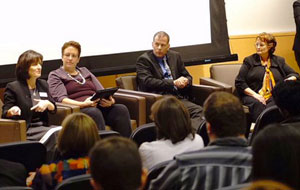Is Syracuse University addressing the gap in higher education regarding science, technology, engineering, and mathematics (STEM) education of students? The short answer is: yes, and in plenty of ways.
A more extensive response to that question was provided by the leaders of Syracuse University’s Colleges of Engineering and Computer Science; Information Studies; Education; and Arts and Sciences last week. At a public Deans’ Panel discussion, panel members talked of how, through an array of existing programming and new initiatives, the University is addressing STEM education challenges and is working actively to attract more students into the STEM fields.
The panel was part of the events organized for Orange Central, the University’s homecoming celebration.
 Moderated by College of Engineering and Computer Science alumnus Alland Leandre, ’88, panel members spoke to a full-house audience on the topic, “Stemming the Gap in Higher Education.” Participating were School of Information Studies (iSchool) Interim Dean Jeffrey Stanton; Dean Teresa Dahlberg of the College of Engineering and Computer Science; Dean Joanna Masingila, of the School of Education; and Dean of the College of Arts and Sciences, Karin Ruhlandt.
Moderated by College of Engineering and Computer Science alumnus Alland Leandre, ’88, panel members spoke to a full-house audience on the topic, “Stemming the Gap in Higher Education.” Participating were School of Information Studies (iSchool) Interim Dean Jeffrey Stanton; Dean Teresa Dahlberg of the College of Engineering and Computer Science; Dean Joanna Masingila, of the School of Education; and Dean of the College of Arts and Sciences, Karin Ruhlandt.
A video preceding the discussion profiled a range of SU’s STEM initiatives, including The Robert Noyce Scholars Program, which responds to the critical need for mathematics and science teachers by encouraging talented STEM students and professionals to pursue teaching careers in high-needs K-12 schools; and The Louis Stokes Alliance for Minority Participation (LSAMP), which helps students bridge key transitions from high school to college; from college into graduate school; and ultimately into a rewarding career in STEM. Other STEM-field programs highlighted were Data Day, It Girls Overnight Retreat, Syracuse University ADVANCE, ECliPSE, Erupt, Empower, and Women in Science and Engineering (WiSE). Panel participants then focused on the question, ‘What can Syracuse University do to attract more undergraduates to the STEM disciplines?”
Make It Relevant
Dean Teresa Dahlberg cited her College’s bioengineering program, the third largest major of 10 at the College, as “a good example of what we’re doing right” to attract students to the STEM fields. In addition to its current high level of interest, growth of 62% leading up to 2020 is expected, and that’s because the school promotes the program’s social relevance and interdisciplinary nature. “Students want to work on something that matters so they can make a difference,” Dr. Dahlberg said. In addition, the Biological Materials Institute at Syracuse provides an active research ground where students can immediately see the impact of how their studies apply in the real world, and research that improves quality of life is an aspect of STEM studies that is attractive to students, she added.
Mentor Faculty
At the College of Arts and Sciences, assuring that STEM students have exceptional academic experiences once they are on campus is essential to retaining them, Dean Karin Ruhtlandt believes. Her College is “making sure that we connect what is taught in the classroom with everyday experience, or with research in the lab; that is absolutely critical to grow STEM.” She cited “a really remarkable” 17% growth in the amount of research funds SU has received of late, as compared to the typical rate of below 10%. She attributed that success to the University’s “concentrated effort made in the STEM areas to bring in extremely talented junior faculty members” over the last 10 years. Significantly, the University has supported those new faculty so they are able to provide excellent classroom experiences to students by equipping them well and mentoring them. Dean Ruhtlandt noted of those faculty, “There’s actually more we expect from them than just the research. Yes, we like them to get grants, and be nationally and internationally visible, but we want them all to be amazing teachers, because after all, we are a university and education is what we’re here for.”
Pay As Tactic
In a very practical sense, one tactic for engaging undergraduate students in research work is to “pay them,” iSchool Interim Dean Jeff Stanton said to hearty audience laughter. “I’m only half-joking,” he cajoled, noting the availability of National Science Foundation (NSF) funds specifically designed to involve undergraduate students in research work by providing add-on monies for faculty grants. Stanton said that on any NSF grant, “you can ask for extra money that’s for REU (research experience for undergraduates),” and he encourages iSchool faculty members to “get the REU supplement in order to get undergrads involved,” he said. In addition, the School has developed some best practices in faculty culture and faculty life related to working with students in research efforts “that would be advantageous to roll out over the whole campus, across every discipline, not just STEM disciplines,” he encouraged.
Teaching to Test
Joanna Masingila, Dean and professor at the School of Education, was asked about how well students are prepared in the math and science fields from the time they start kindergarten through their high school years so that they are well prepared to continue with STEM success in college.
Noting a severe shortage of math and science teachers in this country in general, she said that situation makes finding sufficient levels of qualified STEM subject teachers more difficult, and sometimes, teachers who haven’t had a particular focus on those subjects must teach them regardless. In addition, most states now have teaching accountability systems, she noted, and “that puts a lot of pressure on K – 12 education. It puts a lot of pressure on teachers and sometimes creates a culture of teaching to the test,” a situation which she observed, “is not helpful” to overall student learning.
Original reporting by Diane Stirling
